#osamu kaneda
Explore tagged Tumblr posts
Text

Comments from Osamu Kaneda, Masayuki Ozaki, and Taisuke Morisaki from the Tiger & Bunny The Live Official Book.
If this is translated somewhere please let me know and I’ll link to it.
3 notes
·
View notes
Text

Kamen Rider Decade: All Riders vs. Dai-Shocker (2009) by Osamu Kaneda
2/5, Tokusatsu, Action Adventure
This sure was a movie that I watched. Finally more Tsukasa back story but I also didn't really care about his sister and her sob story.
Poor Natsumi, felt so bad for her in this, she, better get a happy ending after the two episodes and movie I still have left to watch.
0 notes
Text
295. Kamen Rider Kuuga - Hidenori Ishida, Katsuya Watanabe, Takao Nagaishi, Nobuhiro Suzumura, Osamu Kaneda
Essa série me impressionou demais, eu esperava apenas uma experiência divertida e brega. Mas recebi uma história cativante, repleta de personagens incríveis e momentos incríveis. Godai é de longe um dos melhores protagonistas que eu já vi. Provavelmente uma das melhores escolhas para um primeiro tokusatsu.
★★★★☆


1 note
·
View note
Photo

4 notes
·
View notes
Text




finally finished rereading Akira, so to avoid work i decided to try and translate Kaneda and Tetsuo into Tezuka's manga style of characters.
(damn this shit sucks though, tbh they look w a c k)
7 notes
·
View notes
Photo

Bad movie I have The Forest 2016
#The Forest#Gramercy Pictures#Natalie Dormer#Eoin Macken#Stephanie Vogt#Osamu Tanpopo#Yasuo Tobishima#Ibuki Kaneda#Akiko Iwase#Kikuo Ichikawa#Noriko Sakura#Jozef Aoki#Yûho Yamashita#Taylor Kinney#Gen Seto#Terry Diab#Nadja Mazalica
3 notes
·
View notes
Text
Animation Night 88: 08th MS Team
Hi friends, it’s a Thursday, which means I would like to show you some animations!
This week’s number is unfortunately inauspicious in political numerology, and what’s worse it will be a very long time until Animation Night 1312 by which point we’ll surely have run out of animated films, but since I have kind of already shown the major antifascist animated films I know about, let’s instead just use the number 8 to signify... a buncha gundams!
All together now... Moeaagre GANDAMU~~~!
youtube
...ok, not actually that particular Gundam, but the song is such a banger that I had to post it.
Gundam is of course the oldest and mightiest mecha franchise, the jewel in the crown of the venerable anime studio Sunrise, and highly influential as the lead of the ‘real robot��� subgenre that took over from the prior ‘super robot’ shows. Gundam models, or Gunpla, are one of the core otaku industries. Gundam is sufficiently popular that they’ve even gone and built ‘life size’ gundam statues - soon to be four of them, in fact. We’ll talk about how this came to be in a little bit, but first let’s try to lay out the map a little bit.
If, like me, you’re curious to know what the fuss is about, you kind of hit a wall in that there is just so much Gundam, and it’s arranged so haphazardly that being a fan of Gundam has been likened to being a historian. Where do you begin? You will fairly soon discover that the Gundam title comprises several different, separate multipart stories, known as ‘timelines’. So some Gundam stories, such as Iron Blooded Orphans, are separate stories linked to the brand only by some similarities of design and shared staff. However, most of the material falls into one primary series, known as the Universal Century timeline. That’s the one that began in 1979 with Mobile Suit Gundam (機動戦士ガンダム Kidō Senshi Gandamu).
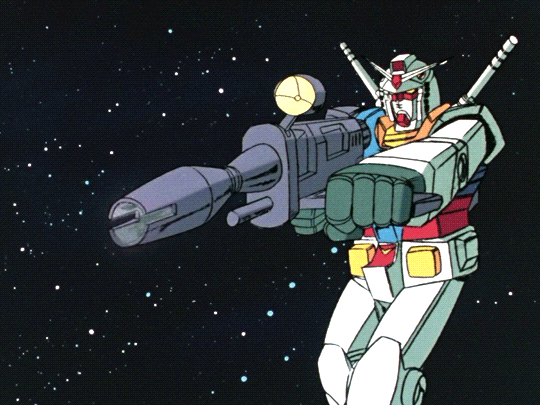
At the time Gundam arrived on the scene, mecha anime (anime about machines, primarily humanoid robots) was already well established as one of the major subgenres, closely linked to tokusatsu in terms of target demographics and sensibility.
Back then, mecha shows typically fell into a genre known as ‘super robot’. Here, the robots were essentially a kind of scifi spin on a superhero: a one of a kind machine with wondrous abilities. So let’s begin our history of Gundam a little earlier, with a history of robot anime in general.
Humanoid robots in manga originate in Tetsujin 28-gō (1956) [lit. Iron Man No. 28] by Mitsuteru Yokoyama, which you may recall cited by Otomo as a major influence on Akira; it featured a military robot built in the last days of the Japanese Empire repurposed by the son of its creator. Yokoyama drew on a number of his sources: primarily the manga of Osamu Tezuka (Animation Night 80), particularly Metropolis (whose adaptation by Rintaro we watched on Animation Night 53). But it also drew on his experiences living through the levelling of Kobe by American B-29 bombers, the 1931 film adaptation of Mary Shelly’s novel Frankenstein, and the rumours of secret Nazi weapons projects.
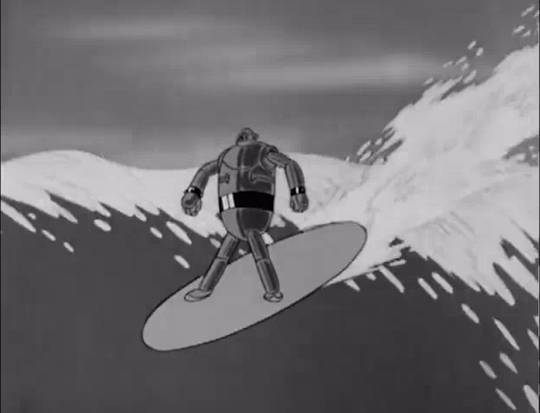
Much like Frankenstein’s monster, the robot in Tetsujin is not intrinsically good or evil; the manga’s protagonist, Shotaro Kaneda, manages to get to it before a group of gangsters and becomes a kind of boy detective figure insistent on using the robot for peace. The idea of sitting inside a humanoid robot had not yet become established, and Shotaro controlled it remotely. Design-wise, it’s much more a product of 50s movies than the distinctive Japanese robot aesthetic which would snowball later.
Alas, beyond that short summary, I have not on a brief look been able to find any scans of the manga, so I can’t tell you how it ends, or what thematic resolution they find. Regardless, Tetsujin was wildly popular, which had a variety of impacts - awkwardly, one of them being the coinage of the term ‘shotaro complex’ as a counterpart to ‘lolita complex’. It received an early anime adaptation in 1963, which like Speed Racer (Toku Tuesday 20) was redubbed in the first wave of anime localisations in America by Fred Ladd as Gigantor, removing the historical setting and tone down the violence; the same happened to the 1980 series. Subsequently, the short-lived Palm Studio produced a more faithful anime adaptation directed Yasuhiro Imagawa in 2004.
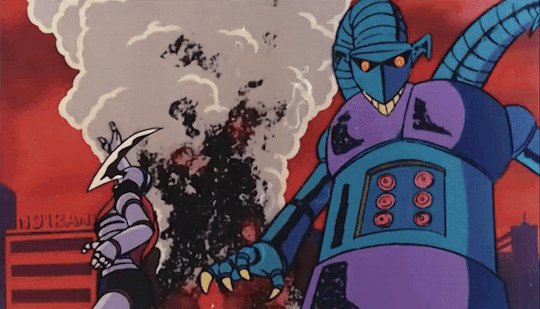
(^ Mazinger Z (1972) - here you can see how much simpler mech designs are in this period: spheres and cylinders, and rather inconsistent dark reflections. as we’ll see, this would be refined to an insane degree over the coming decades)
However, this was not yet a genre. Super robots truly became established in the 1972, when Go Nagai (of Devilman fame) published a manga called Mazinger Z. This introduced the idea of sitting inside the robot, and set the pattern for many plot elements. The protagonist’s father Professor Kabuto is a scientist whose boss Dr. Hell (no really) finds an army of robots under the Earth and decides to go for world domination; escaping, creates a special, advanced robot before being killed (and, trust Nagai, by “Baron Ashura, a half-man, half-woman”); his son must pilot the robot to fight Dr. Hell’s army.
As usual, Nagai had his finger on the psychic pulse, and his new storytelling formula became wildly popular. It very soon received an anime adaptation by Toei, and inspired a wide wave of imitators which copied most of the plot points. Like tokusatsu, the format gave them the ability to design a variety of weird looking enemies each week - just drawings instead of rubber suits.
Action animation at this point was still pretty stiff: the complex multi-layered camera movements of Ichiro Itano were still a long way to being invented. But it was a time of major change: the gritty gekiga style popular in manga of the time was spreading to anime with series like Tiger Mask and Ashita no Joe, and this is about the time when a young Yoshinori Kanada was starting his career. So the new genre of robot anime rode this wave, and proved a perfect fit for the Kanada’s emphases: striking poses, light flares, strong solid drawing varying framerate, playful physical comedy... and indeed, much of Kanada’s early work is on early shows like Getter Robo G.
youtube
Still, despite the new flashy innovations in animation techniques which were starting to define a distinctly anime style that could make the most of limited drawing counts, these super robot shows were largely telling the same sort of stories with the same primary drive: selling toy robots to children. And while you could totally read them as geopolitical, nationalist metaphors - the robot fighting off the monster of the week sublimating the resentment of Japan defending itself against the allies - they were on the surface level pretty black and white.
So it’s time to enter... Yoshiyuki Tomino!
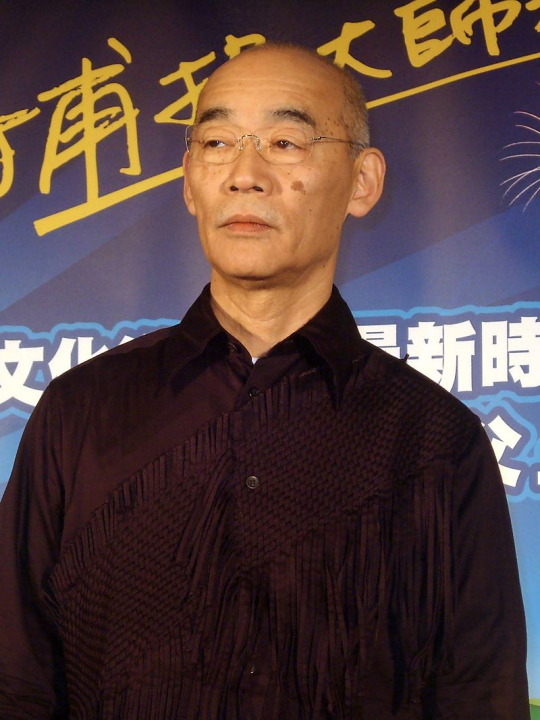
(he did not look like this in 1979!)
Well, OK, not so much enter. Yoshiyuki Tomino not only already on the scene by ‘79: he started work all the way back on Astro Boy in writing and storyboarding. Before long he started directing his own shows adapted a Tezuka manga, Blue Triton, as Triton of the Sea (1973), making an early stab at complicating the very black and white narrative of the original - and also setting up his reputation as ‘kill ‘em all’ Tomino by wiping out much of the cast by the ending.
He started working in the robot genre with Brave Raideen (1975) and Invincible Super Man Zambot 3 (1977-8), the latter apparently the point where the ‘kill ‘em all’ nickname stuck. But he was growing frustrated with the limitations of super robot shows. In Invincible Steel Man Daitarn 3 (1978), he started introducing more complex story elements from other genres, like spy stories and ironic pastiches. Evidently something was ripe for a change.
But the real break came in 1979, with Mobile Suit Gundam. The idea was to mix a robot show with hard science fiction space opera, and realism became a central drive - which is as has been hashed out endlessly since, an inherent contradiction since humanoid robots are far from practical military equipment. But the combination of meticulously observed machine animation and tragic war stories with cool humanoid robots proved explosively influential...
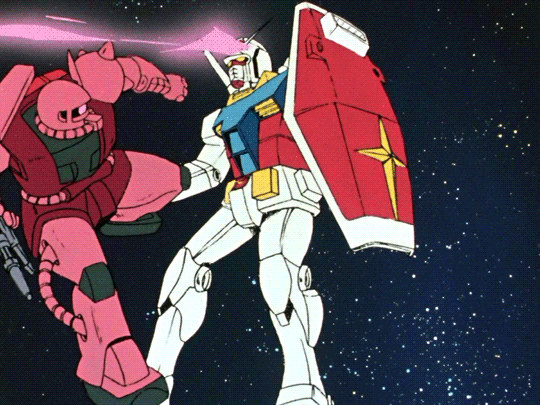
(^ this is an ambitious cut for the period, but notice how the Gundam (white mecha)’s legs change in size and proportion! they hadn’t quite got it at this point)
The title ‘Gundam’ is quite literally ‘gun dam’. It actually began as a portmanteau of ‘gun’ and ‘freedom’, with early iterations of the story imagining that the protagonists would belong to a ‘Freedom Base’, but Tomino changed it to ‘Gun Dam’ with the metaphor of a robot holding back enemies like a dam holding back water.
What was science fiction like at this time? Over in the English language, we could look at the Hugo Awards shortlist, where we’ll see Le Guin, Asimov, Clarke, Haldeman, Cherryh, Niven... or perhaps we could look at blogs like @70sscifiart. So a time of high concepts, space operas, and Vietnam metaphors... hard sci-fi was pretty central, and still considered a genuine speculative exercise rather than a nostalgic pantomime of a past genre.
And, of course, the US had only recently stopped sending people to the Moon, Japan was still riding an economic boom, there was still a Soviet Union and a Cold War and at least nominally still nominally a Space Race; the idea that humans would soon find their way to space en masse must have seemed much less of a romantic fantasy, but also the idea that once humans got up there they’d immediately stage an enormous scale war would have seemed all too plausible.
So Gundam is full of hard sci-fi concepts like helium-3 fusion and Lagrange point colonies. They go to great lengths to attempt to justify the central ‘humanoid robot’ premise as a reasonable military strategy with the convoluted concept of a ‘Minkowski particle’. But that’s details; what’s the narrative thrust?
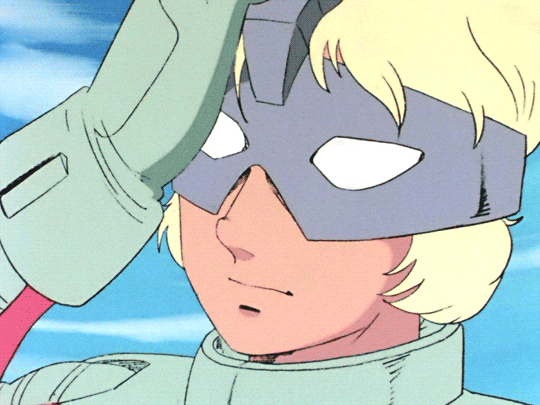
(^ this twink is Char, the major rival character/villain.)
The first Gundam doesn’t walk too far away from its super robot predecessors. A secessionist faction called Zeta, who are portrayed at this point entirely unsympathetically as fanatical and more than a little fashy, launch a war using their mecha which wipes out half of humanity. The protagonists belong to a polity called the Federation, which has developed a powerful new robot called (guess what) a Gundam. However, when they go to collect this robot, Zeta attacks. The protagonist, Amuro, gets in the robot and fends them off; in the process, he discovers he’s some kind of new evolution of humanity better adapted to space which becomes known as a Newtype, and thus becomes the regular Gundam pilot.
He’s opposed primarily by Char, a Zeta pilot who is modelled closely on the career of the Red Baron. Although flying for Zeta, Char has his own designs, and exploits the war to do away with the rival Zabi family who killed his peace-loving father. Naturally the series ends with Char facing Amuro in a duel - but Char realises at the last minute that he’s lost sight of his true goal (killing the Zabis) and flees to finish them off instead.
This story of rivals on either sides of a war with all attendant sexual tension (and bearing in mind Tomino’s Gundam is, I understand, far from kind to its girls) proved wildly popular. For Tomino, the principal theme is famously an anti-war one: despite all the cool robots they get to play with, going to war brings only tragedy to the cast.
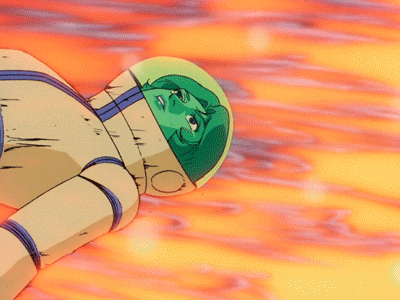
He pushed this even harder in his next project, Space Runaway Ideon (1980) about a group of humans in Andromeda running from a powerful military faction in ancient alien tanks, which despite first being cancelled on its original TV run, was able to finish its story in a final movie that’s known for mercilessly slaughtering its cast. (Which I would like to watch at some point so I can say something more about it than ‘haha... death...’)
Meanwhile, the Gundam juggernaut was getting seriously underway. The 1979 series was summarised in a trilogy of three movies (coming to a future Animation Night). The release became a notable event...
The first Gundam film, upon release on 22 February 1981, drew a large crowd of 15,000 people at its premiere, leading to concerns from police and media that it could lead to social unrest from a riotous crowd. The event is considered a turning point in the history of anime, referred to as "the day that anime changed" according to Asahi Shimbun newspaper.[20]
...although sadly I can’t report on a Gundam riot, fascinatingly as that would be.
Tomino set a certain tone for the mecha genre: a simultaneous fascination with military technology and deep antipathy, or at least ambivalence, towards its purpose. The psychological realism of his characters also developed, from the more iconic superhuman pilots of a super robot show to an attempt towards people who act irrationally, suffer war trauma, and can drive a story through their desires rather than stepping into the familiar roles of prosocial/antisocial. The mecha was increasingly a vulnerable body, able to be gruesomely destroyed; the dead pilot whose blood seeps out of the cockpit. (This was, therefore, a major step towards the territory of Neon Genesis Evangelion on the one hand, and the films of Mamoru Oshii such as Patlabor on another.)

This political theme was not a natural thing either, but explicitly contested by animators. Shortly after Gundam, the industry was shaken by the Future War 198X controversy, related by Matteo Watzky here. (Hey Matteo, if you read this, sorry I keep selling your name wrong with two ‘t’s. ><) In this event, a large portion of the industry signed open letters and protested the production of a near-future war film imagining a future World War III. Like Gundam, the film put a huge emphasis on realism, claiming to be an accurate projection of what such a war would look like. For many animators, this felt too much like profiting off militarism, and the unions were far from happy about its negative depiction of the Soviet Union. The result was a partial victory: the movie was made, but with an edited script ending in a rather clunky pacifistic ending in which a Star Wars-like program destroys all the missiles.
Over time, however, this political strand would diminish as anime increasingly became continuous with the notoriously apolitical otaku subculture. Gundam sits in an odd place: it is perhaps the epitome of otaku media as the source of highly profitable gunpla models, but despite that, its films and series insist on attempting to return to the same ‘anti-war’, more or less overtly political themes.
Of course, such territory is risky, and it won’t always be executed well. Gundam can end up as just characters with hilariously weird names launching into long but ultimately incoherent political rants. Over time, it attempts to add a more sympathetic dimension towards the aristocratic Zeon faction, with Char in particular swapping from antagonist to protagonist in the next series, and then going back round to antagonist again in the landmark film Char’s Counterattack (1988), a major accomplishment of animation which is unfortunately gated behind about a hundred episodes of TV anime to set the context. One day I’m going to figure out how to show it to you!
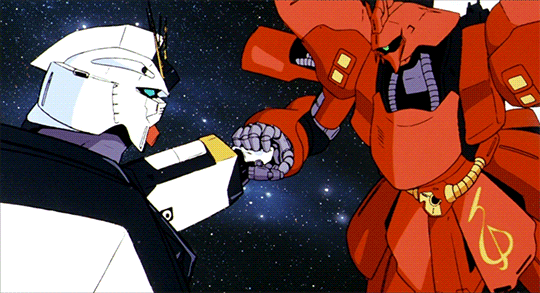
(^ note how much more detailed the mechanical designs are, and how much more consistently they are animated! the camera is also much more mobile, and the general sense of weight and motion is considerably more developed. Per sakugaboor, this cut was animated by Kouji Koizumi.)
Along the way, however, another strand of Gundam developed. While the main series emphasised big robot battles and dramatic rivalries playing out over decades, these side story OVAs tended to go for something a little smaller scale. War in the Pocket (1989), the one which I’ve seen, focuses on children in an O’Neill cylinder space colony who, running on militaristic fantasies, get pulled into the space war on different sides when some mecha crash into their habitat. Inevitably, they end up tragically dying in a futile skirmish.
08th MS Team comes much later, at the tail end of the 90s, when the realist movement in anime was well established. Its 90s stylings are certainly very clear in its character designs...
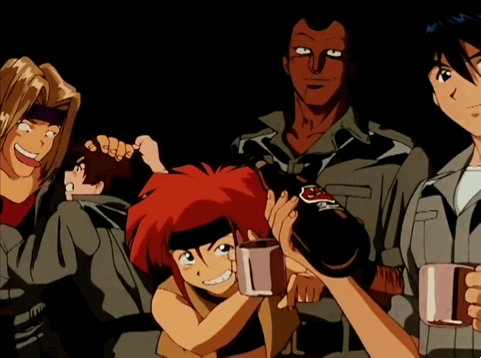
More so than the other Gundams, which tend more often to present superhuman pilots having flashy battles and high stakes duels in space, this iteration of Gundam attempts to be a gritty, down-to-earth war story. It pulls the battle down to Earth during the period of the first movie, with the fights consisting of tense jungle warfare emphasising lines of sight and logistics; its characters are seasoned and cynical soldiers rather than young prodigies.
The story naturally focuses on a connection forming between fighters on either side of the war - indeed, star-crossed lovers, Federation pilot Shiro newly assigned a command and talented Zeon pilot Aina. Shiro finds his loyalty in question when his rescue of Aina from a space wreck at the beginning of the show is discovered, and he is ordered to take his ragtag crew on a mission to destroy Aina. So it’s that juicy territory of personal vs political relationships, transcending inherited conflicts, etc. etc.
Animation-wise, 08th MS Team is also exceptional, coming at the tail end of the cel era and featuring many talented realist animators, such as Akihito Yamashita who would later work on Ghibli films - and even a young Yutaka Nakamura on his rise to the household-name (to anime fans) Sakuga Throne. The skill of these animators allows the robots to move with exceptional weight and presence, and interact believably with water and their environment, like in this iconic shot of a robot firing from behind a shield:

This makes fantastic use of an impact frame, slow-out, lighting on the environment, and especially secondary motion such that you really feel the force of this big gun. This is Sunrise at their absolute high point of traditional mecha animation, standing up to compete with the likes of Gainax’s Royal Space Force: The Wings of Honneamise (Animation Night 29).
The character animation is similarly strong, in that sharp 90s way; you can tell this is of an era with Eva and Macross Plus (Animation Night 64), but the characters are able to express a lot of subtle acting. For these reasons, and the strength of the story, 08th MS Team is widely recommended as a starting point for the Gundam-curious. So that’s where we’ll begin tonight - and if we still feel in a Gundam mood, at some point I’ll take us back to the trilogy of movies summarising the original 1979 Gundam, and then, well who knows?
(One strand I haven’t touched on much in this writeup is the actual mechanical design of the robots themselves - the substrate on which all of this is built. This is, alas, because I’m not particularly well informed about that subject! I hope I’ll be able to get to it in a future writeup, drawing on sites like zimmerit.moe. Surely someone has a compiled a history of Gundam design?)
We’re all out of time right now: we’re going to have to take a pretty brisk pace to get through the full OVA tonight, so, strap into your mobile suit and head over to twitch.tv/canmom and we’ll take flight shortly!
18 notes
·
View notes
Text
Comfort Characters🖤
(Black Edition)
Shotaro Kaneda - Akira

Yuuta Okkotsu - Jujutsu Kaisen

Lelouch vi Britannia - Code Geass

L Lawliet - Death Note

Roy Mustang - Fullmetal Alchemist

Levi Ackerman - Shingeki no Kyojin

Tomioka Giyuu - Kimetsu no Yaiba

Isagi Yocihi & Itoshi Rin - Blue Lock

Gilbert Nightray - Pandora Hearts

Dazai Osamu - Bungou Stray Dogs

Special Mentions:
Ray - Promised Neverland
Muichiro Tokito - Kimtesu no Yaiba
Gen Asagiri - Dr Stone
Tetsurō Kuroo - Haikyuu!!
Subaru Mimura - 2.43: Seiin Koukou Danshi Volley-bu
Gareki - Karneval
Aki Hayakawa - Chainsaw Man
Kayden - Eleceed
Sung Jinwoo - Solo Leveling
Hatz - Tower of God
#kaneda shoutarou#akira#yuta okkotsu#jujustu kaisen#lelouch vi britannia#code geass#l lawilet#death note#roy mustang#fullmetal alchemist#levi ackerman#shingeki no kyojin#attack on titan#tomioka giyuu#kimetsu no yaiba#demon slayer#isagi yoichi#itoshi rin#blue lock#gilbert nightray#pandora hearts#dazai osamu#bungou stray dogs#babies#comfort characters#i adopted too many childrens#anime#manga#rin and isagi is a set here just bcs im smart that way aka im saving space#i have more black haired ccs but i cant write or tag them all just bcs look at all of the black haired mc out there? yes that exactly
89 notes
·
View notes
Text
𝐎𝐂 𝐅𝐈𝐋𝐄𝐒 — 𝐇𝐀𝐘𝐀𝐒𝐀𝐊𝐀 𝐑𝐀𝐍𝐙𝐄

𝚝𝚑𝚎 𝚏𝚒𝚛𝚜𝚝 𝚒𝚗𝚜𝚝𝚊𝚕𝚕𝚊𝚝𝚒𝚘𝚗 𝚘𝚏 𝚖𝚢 𝙾𝙲 𝚒𝚗𝚏𝚘𝚛𝚖𝚊𝚝𝚒𝚘𝚗 𝚜𝚑𝚎𝚎𝚝𝚜. 𝚎𝚗𝚓𝚘𝚢 𝚝𝚑𝚒𝚜! ♥︎
◣ 𝐆𝐄𝐍𝐄𝐑𝐀𝐋 𝐈𝐍𝐅𝐎 ◥
NAME — Ranze Hayasaka : 蘭世早坂
AGE — 16 years old
SPECIES — human
GENDER — female
PRONOUNS — she/her
BIRTHDAY — 12.27.2014
ETHNICTY — Japanese
BLOOD TYPE — AB
HOROSCOPE — ♑︎ sun, ♓︎ moon, ♋︎ rising
HEIGHT — 5’6” // 168 cm
WEIGHT — 114 lbs // 50 kg
SEXUALITY — bisexual
◣ 𝐏𝐇𝐘𝐒𝐈𝐂𝐀𝐋 𝐀𝐏𝐏𝐄𝐀𝐑𝐀𝐍𝐂𝐄 ◥
EYE COLOUR — dark brown
HAIR COLOUR — jet black
SKIN COLOUR — pale ivory
BODY TYPE — inverted triangle | slender
➯ Ranze is described to be a very slender and beautiful young woman, emulating the ideal Japanese woman in both her looks and personality. she has a lissom body and has lovely assets, standing at 5’6” and weighing 114 lbs.
➯ her ebony hair is straight and has bangs cut into the typical style for Japanese women. she has dark chocolate eyes and has very pronounced thick eyebrows that she inherited from her mother, Hana, whom she bears a great resemblance to.
AESTHETIC — grunge Y2K, alternative, preppy
COLOUR PALETTE — various shades of red, dark purple, navy blue, black, and yellow

◣ 𝐏𝐄𝐑𝐒𝐎𝐍𝐀𝐋𝐈𝐓𝐘 ◥
MBTI TYPE — INFJ-A
ENNEAGRAM — type 9
MORAL ALIGNMENT — neutral good
➯ Ranze is a conservative, cool, disciplined, and highly rational individual. she is someone who takes on a very careful approach to things and is often seen as ambitious and focused. she almost never dwells on things she deems as “silly” or “pointless” as she holds great concentration.
➯ Ranze is also quite spiritual, being a very devote practitioner of the Shinto religion—even becoming a shrine maiden later on in the story. she is a deeply considerate and patient human being, showing a very tender and motherly side to her comrades.
➯ though she does seem to have very low expectations for men, given that she’s grown up in an environment where she’s been disrespected by them so frequently. but this mindset changes when she starts to harbour feelings for Kaneda Shoutarou.
◣ 𝐅𝐀𝐕𝐎𝐔𝐑𝐈𝐓𝐄𝐒 ◥
COLOUR — red and purple
MUSIC — alternative, rock, nu-metal
FOOD — oyaki, fugu (pufferish), zaru soba
BOOK — the setting sun (osamu dazai)
PHRASE — “i don’t think there’s a ever a good excuse to wallow over the past”
ACTIVITY — fortune-telling // meditation
PLACE — shinto temples // her bedroom
◣ 𝐏𝐋𝐀𝐘𝐋𝐈𝐒𝐓 ◥
i disagree — poppy
mastermind — mindless self indulgence
oblivion — grimes
some things cosmic — angel olsen
class of 2013 — mitski
copy cat — melanie martinez
perverted — elita
broken clocks — SZA
beautiful & bad — nicole dollanganger
𝚊 𝚜𝚙𝚎𝚌𝚒𝚊𝚕 𝚝𝚑𝚊𝚗𝚔𝚜 𝚝𝚘 𝚝𝚑𝚎 𝚋𝚎𝚊𝚞𝚝𝚒𝚏𝚞𝚕 @foxshrine 𝚏𝚘𝚛 𝚝𝚑𝚎 𝚐𝚘𝚛𝚐𝚎𝚘𝚞𝚜 𝚖𝚘𝚘𝚍𝚋𝚘𝚊𝚛𝚍 𝚘𝚏 𝚁𝚊𝚗𝚣𝚎. 𝚊𝚗𝚍 𝚝𝚑𝚊𝚗𝚔 𝚢𝚘𝚞 𝚏𝚘𝚛 𝚛𝚎𝚊𝚍𝚒𝚗𝚐 𝚝𝚑𝚒𝚜 𝚋𝚒𝚘! 𝚜𝚝𝚊𝚢 𝚝𝚞𝚗𝚎𝚍 𝚏𝚘𝚛 𝚖𝚢 𝚗𝚎𝚡𝚝 𝚘𝚗𝚎 𝚌𝚘𝚖𝚒𝚗𝚐 𝚜𝚘𝚘𝚗~
4 notes
·
View notes
Text
PLEASE READ
☆꧁༒☬༒꧂ ☆
ABOUT ME
my name is nemo !!
i write for both HQ and DAIYA
my favourite characters are MIYUKI, SAWAMURA, HARUICHI, HINATA, BOKUTO, and SUGAWARA. probably more i love everyone
☆꧁༒☬༒꧂☆
GUIDELINES
i only write reader x character
gender neutral terms unless you request for pronouns
SFW and SUGGESTIVE writing/request only. like how they kiss or making out. NSFW later once i’m comfortable.
i can deny any request that makes me uncomfortable. my ask box will always be open !! for small drabbles or just talking when request are closed.
I write headcanons for up to five people, the more people the less detailed. scenarios one character at a time please !
WON’T WRITE
topics that are harmful/triggering (self-harm, suicide, implied or direct mental illness, etc.)
omegaverse
pedophilia
huge age gaps
no teacher x student
nothing overly NSFW
characters i don’t have a good understanding of, or don’t feel comfortable writing for
☆꧁༒☬༒꧂☆
CHARACTERS I WRITE FOR
HAIKYUU
sugawara
dachi
asahi
nishinoya
tanaka
kageyama
hinata
tsukishima
yamaguchi
coach ukai
kiyoko
kuroo
kenma
lev
yaku
oikawa
matsukawa
hanamaki
iwaizumi
kunimi
mad dog
bokuto
akaashi
konoha
ushijima
semi
goshikishirabu
tendou
terushima
atsumu
osamu
suna
aran
sakusa
ACE OF THE DIAMOND CHARACTERS
tanba
yuki tetsuya
ryosuke
jun
chris
miyuki
kuramochi
watanabe
kawakami nori
shirasu
haruichi
sawamura
furuya
kijima
toujou
manemaru
takatsu
kaneda
yuki masahi
yui
seto
okumura
kuki
coach kataoka
sanada
raichi
hayakawa
tomobe
you shinshin
harada
mei
tadano
shirakawa
carlos
shinji
mukai
matsubara
umemiya
maki
amahisa
10 notes
·
View notes
Text
Tags Part 2
For more tags please see here and here
By Seiyuu: Hiroaki Hirata Masakazu Morita Yuichi Nakamura Minako Kotobuki Kenjiro Tsuda Go Inoue Mariya Ise Nobuhiko Okamoto Taiten Kusunoki Koji Yusa Tomori Kusunoki Nobunaga Shimazaki Shoya Chiba Rina Hidaka Katsuhisa Houki Hiroshi Iwasaki Yuuko Kaida Shinichiro Oota
By Staff: Yoshihiro Ike Tokio Inoue Osamu Kaneda Atsuko Kase Masakazu Katsura Ruriko Kojima Chinatsu Matsui Taisuke Morisaki Masafumi Nishida Masayuki Ozaki Mizuki Sakakibara Keiichi Sato Tomohiro Suzuki Yuuya Takahashi Kazuhiko Tamura Hiroshi Ueda Yoshitomo Yonetani
By Singer/Band: Novels Aoubozu Rihwa Tamaki Unison Square Garden
By Year: 2011 2012 2013 2014 2015 2016 2017 2018 2019 2020 2021 2022 2023 2024 Unknown Year
By Event: Characro Hero Awards Hero TV Jack MBS Anime Fes Namjatown Precious Eve Radio Show Sunrise Fesitval The Rising Super Prelude The Sound of Tiger & Bunny The Sound of Tiger & Bunny 2016 The World of Tiger & Bunny Tiger & Bunny The Live
By Game: Mobage Hero's Day My Private Hero On-Air Jack Pachislot PSP Road of Hero V Residence Video Game
6 notes
·
View notes
Text

Kamen Rider x Super Sentai: Chou Superhero Taisen (2017) by Osamu Kaneda
2/5, Tokusatsu, Adventure, Science Fiction
The team ups were fun but the refusal to let Poppy transform and fight as well annoyed me, they let Hammie and Amu fight too so like come on man.
0 notes
Photo
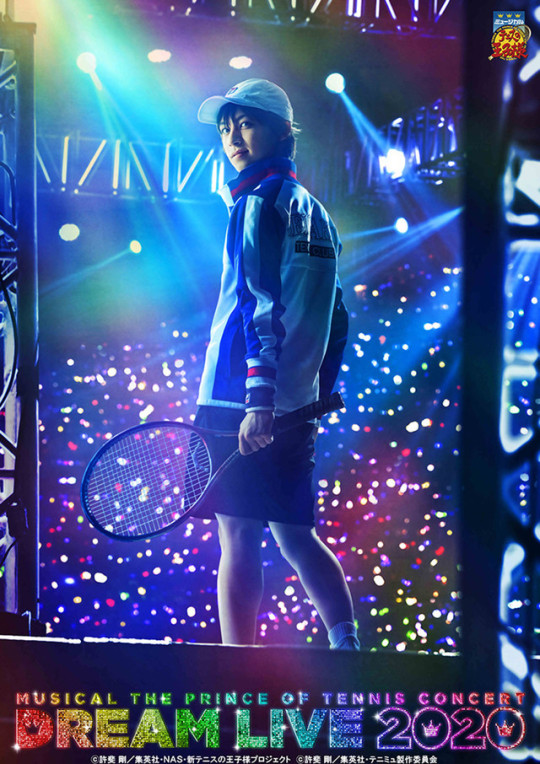
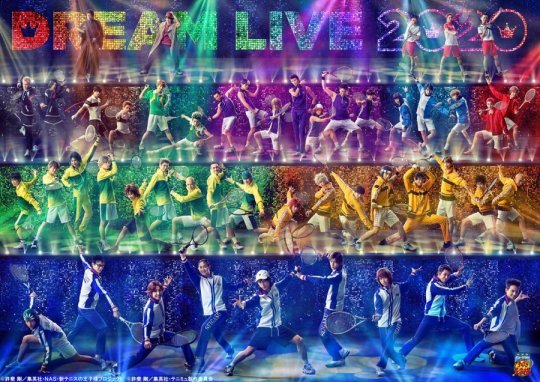
[Update] ミュージカル「テニスの王子様」コンサート Dream Live 2020 (musical tennis no oujisama concert dream live 2020)
(higawari) cast update under the cut^^
Cast:
Seigaku:
Akutsu Nichika as Echizen Ryoma (越前リョーマ) Aoki Ryou as Tezuka Kunimitsu (手塚国光) Ezoe Takanori as Ooishi Shuuichirou (大石秀一郎) Minaki Ibu as Fuji Shuusuke (不二周助) Taguchi Tsukasa as Kikumaru Eiji (菊丸英二) Takenouchi Daisuke as Inui Sadaharu (乾貞治) Iwata Tomoki as Kawamura Takashi (河村隆) Ookubo Tatsuki as Momoshiro Takeshi (桃城武) Nakajima Takuto as Kaidou Kaoru (海堂薫) Ryouga as Horio Satoshi (堀尾聡史) Nakamigawa Toshiki as Katou Kachirou (加藤勝郎) Okuda Yumeto as Mizuno Katsuo (水野カツオ)
Rikkai:
Tateishi Toshiki as Yukimura Seiichi (幸村精市) Tazuru Shougo as Sanada Genichirou (真田弦一郎) Isawa Takuma as Yanagi Renji (柳蓮二) Gotou Dai as Niou Masaharu (仁王雅治) Oosumi Yuuta as Yagyuu Hiroshi (柳生比呂士) Ooyabu Taka as Marui Bunta (丸井ブン太) Kawasaki Yuusaku as Jackal Kuwahara (ジャッカル桑原) Maeda Ryuutarou as Kirihara Akaya (切原赤也)
Shitenhouji:
Mashiko Atsuki as Shiraishi Kuranosuke (白石蔵ノ介) Andou Shuutarou as Koishikawa Kenjirou (小石川健二郎) Emoto Kouki as Chitose Senri (千歳千里) Morita Rikito as Konjiki Koharu (金色小春) Yatsu Tsubasa as Hitouji Yuuji (一氏ユウジ) Chida Kyouhei as Oshitari Kenya (忍足謙也) Mori Ippei as Ishida Gin (石田銀) Hirono Ryouta as Zaizen Hikaru (財前光) Hiramatsu Raima as Tooyama Kintarou (遠山金太郎) Saki Masato as Watanabe Osamu (渡邊オサム)
Fudoumine:
Aoki Soramu as Tachibana Kippei (橘桔平) Kento as Ibu Shinji (伊武深司)
St. Rudolph:
Satou Yuugo as Kisarazu Atsushi (木更津淳) Oohara Kaiki as Fuji Yuuta (不二裕太)
Yamabuki:
Morita Touya as Sengoku Kiyosumi (千石清純) Kawakami Shouta as Akutsu Jin (亜久津仁)
Hyoutei:
Isaka Ikumi as Oshitari Yuushi (忍足侑士) Kitano Satsuki as Mukahi Gakuto (向日岳人) Utsumi Akiyoshi as Hiyoshi Wakashi (日吉若)
Miura Hiroki as Atobe Keigo (跡部景吾) [※ May 31st ONLY] Kobayakawa Shunsuke as Shishido Ryou (宍戸亮) [※ May 31st ONLY] Tamura Shougo as Akutagawa Jirou (芥川慈郎) [※ May 31st ONLY] Yamazaki Shougo as Taki Haginosuke (滝萩之介) [※ May 31st ONLY] Yamaki Takanori as Kabaji Munehiro (樺地崇弘) [※ May 31st ONLY] Watanabe Aoto as Ootori Choutarou (鳳長太郎) [※ May 31st ONLY]
Rokkaku:
Yashiro Takuya as Aoi Kentarou (葵剣太郎) Futaba Kaname as Saeki Kojirou (佐伯虎次郎)
Higa:
Mutou Kento as Kite Eishirou (木手永四郎) Yoshizawa Tsubasa as Kai Yuujirou (甲斐裕次郎) Iwaki Naoya as Hirakoba Rin (平古場凛) Raita as Chinen Hiroshi (知念寛) Takada Makoto as Tanishi Kei (田仁志慧) Sonomura Masashi as Shiranui Tomoya (不知火知弥) Matsui Haruki as Aragaki Kouichi (新垣浩一)
Moriyama Eiji as Echizen Nanjirou (越前南次郎)
Higawari:
May 22nd ~ 18:30 Watanabe Daisuke as 4th Generation Tezuka Kunimitsu (青学4代目 手塚国光) Furukawa Yuuta as 4th Generation Fuji Shuusuke (青学4代目 不二周助) Hirata Yuuichirou as 4th Generation Kaidou Kaoru (青学4代目 海堂薫)
May 23nd ~ 12:00 Tawada Hideya as 7th Generation Tezuka Kunimitsu (青学7代目 手塚国光) Yata Yuusuke as 7th Generation Fuji Shuusuke (青学7代目 不二周助) Kuroba Mario as 7th Generation Kikumaru Eiji (青学7代目 菊丸英二) Ishiwatari Mashuu as 7th Generation Momoshiro Takeshi (青学7代目 桃城武)
May 29th ~ 18:30 Kubota Yuuki as 1st Season Atobe Keigo (1stシーズン 跡部景吾) Akiyama Shintarou as 1st Season Oshitari Yuushi (1stシーズン 忍足侑士) Kamakari Kenta as 1st Season Shishido Ryou (1stシーズン 宍戸亮)
May 30th ~ 17:00 Kobayashi Yutaka as 2nd Season Mizuki Hajime (2ndシーズン 観月はじめ) Ookubo Shoutarou as 2nd Season Kaneda Ichirou (2ndシーズン 金田一郎) Jinnai Shou as 2nd Season Yanagisawa Shinya (2ndシーズン 柳沢慎也)
more to be announced!
homepage nelke
21 notes
·
View notes
Text
New Prince of Tennis Birthday list
I haven’t seen a birthday list that’s been updated with the world cup players so I wanted to show them some love and put one together! Please note that this is manga only.
Most recent update: 04/04/2021 [CONTAINS HYOUTEI/RIKKAI FANBOOK SPOILERS] (A character’s bday changed, added Sakurai’s old bday, red highlights senpai has a name now, fixed a typo)
January
2 - Dan Taichi (Yamabuki) 3 - Kabaji Munehiro (Hyoutei) 3 - Mouri Jusaburou (Japanese U-17) 5 - Suzuki Shun (Japanese U-17) 14 - Ryuzaki Sakuno (Seigaku) 15 - Shiranui Tomoya (Higa) 18 - Leon Wakefield (English U-17) 23 - Dodo Obando (American U-17) 25 - Ishida Gin (Shitenhouji) 28 - Richard Sakata (St. Icarus) 31 - Hermes Kounellis (Greek U-17)
February
1 - Duke Watanabe (Japanese U-17) 3 - Koishikawa Kenjirou (Shitenhouji) 5 - Kaji Kazena (Japanese U-17) 7 - Liliadent Krauser (Nagoya Seitoku) 8 - Fuwa Tetsuhito (Japanese U-17) 9 - Murata Hiramasa (Japanese U-17) 13 - Noah Dorgias (Australian U-17) 14 - Ootori Choutarou (Hyoutei) 16 - Apollon Stephanopoulos (Greek U-17) 17 - Habu Itto (Midoriyama) 18 - Fuji Yuuta (St. Rudolph) 19 - Suzuki Yasuharu (Ginka) 22 - Ralph Rhinehart (American U-17) 24 - Jonathan St. Georges (French U-17) 28 - Nomura Takuya (St. Rudolph) 29 - Fuji Shusuke (Seigaku)
March
2 - Katou Kachiro (Seigaku) 3 - Hirakoba Rin (Higa) 4 - QP (German U-17) 5 - Yukimura Seiichi (Rikkaidai) 6 - Watanabe Osamu (Shitenhouji’s Coach) 7 - Kimijima Ikuto (Japanese U-17) 10 - Karupin (Ryouma’s Cat) 14 - Sakaki Tarou (Previously May 24th, since 23.5) (Hyoutei’s Coach) 16 - Kurobe Yukio (Japanese U-17′s Coach) 17 - Oshitari Kenya (Shitenhouji) 19 - A. Frankensteiner (German U-17) 21 - Tachibana An (she may have another birthday stated in a game? citation needed lol) (Fudomine) 25 - Kadowaki Satoru (Makinofuji) 26 - Matsudaira Chikao (Japanese U-17) 29 - Arai Masashi (Seigaku) 31 - Matsudaira Chikahiko (Japanese U-17)
April
1 - Tooyama Kintaro (Shitenhouji) 2 - Akutsu Jin (Yamabuki) 3 - Peter Lambiel (Swiss U-17) 4 - Tamagawa Yoshio (Previously September 23 in Tenipuri Party, updated in Rikkai Club Guide STRENGTH) (Rikkaidai) 7 - Mizuno Katsuo (Seigaku) 9 - Oliver Philips (American U-17) 10 - Tashiro Masahiro (Ginka) 11 - Hirari Tonpei (Japanese U-17) 12 - Zeus Iliopoulos (Greek U-17) 14 - Shiraishi Kuranosuke (Shitenhouji) 15 - Shudo Satoshi (Rokkaku) 16 - Clive Miller (American U-17) 17 - Osakada Tomoka (Seigaku) 18 - Mouri Tatsunori (Fudomine) 20 - Marui Bunta (Rikkaidai) 23 - M. Nobuteru (Tube Republic U-17) 25 - Don Pacino (American U-17) 27 - Toono Atsukyo (Japanese U-17) 29 - Edgard Delacroix (French U-17) 30 - Oishi Shuichiro (Seigaku)
May
5 - Akutagawa Jirou (Hyoutei) 5 - Todoroki Goro (Japanese U-17) 11 - Kaidou Karou (Seigaku) 14 - Orion Stephanopoulos (Greek U-17) 15 - Takei Toshio (Japanese U-17) 15 - Ushida Tetsuo (Murigaoka) 21 - Sanada Genichirou (Rikkaidai) 21 - Aragaki Kouichi (Higa) 25 - Alexander Amadeus (Swiss U-17) 27 - Mizuki Hajime (St. Rudolph) 28 - Minamoto Takuma (Midoriyama) 29 - Tanegashima Shuuji (Japanese U-17)
June
1 - Red highlights senpai a.k.a. Yuuki Kazuki (Hyoutei) 3 - Inui Sadaharu (Seigaku) 4 - Yanagi Renji (Rikkaidai) 7 - Albert Federer (Swiss U-17) 10 - Tsuta Akane (Midoriyama) 13 - Prince Ludovic Chardard (French U-17) 15 - Fukushi Michiru (Ginka) 19 - Leopold Camus de Charpentier (French U-17) 20 - Milky Millman (Australian U-17) 24 - Mutsu Yuuma (Japanese U-17) 25 - Mutsu Yuuho (Japanese U-17) 26 - Konomi Takeshi (Mangaka) 28 - Miyako Shinobu (Japanese U-17) 29 - Chinen Hiroshi (Higa)
July
1 - Timothée Moreau (French U-17) 2 - Kiko Balentien (American U-17) 3 - Minami Kentarou (Yamabuki) 3 - Urayama Shiita (Rikkaidai) 4 - Byoudouin Houou (Japanese U-17) 6 - Banda Mikiya (Yamabuki’s Coach) 6 - Rocky Meredith (American U-17) 14 - Nakagauchi Sotomichi (Japanese U-17) 15 - Charlie Palmer (English U-17) 17 - Mifune Nyuudou (Japanese U-17′s Coach) 18 - Ikeda Masaya (Seigaku) 18 - Sakurai Masaya (Previously July 1 in 20.5, updated in 40.5) (Fudomine) 19 - Ban Rikiya (Japanese U-17) 20 - Zaizen Hikaru (Shitenhouji) 20 - Taira Yoshiyuki (Japanese U-17) 23 - Momoshiro Takeshi (Seigaku) 24 - Kitamura Wataru (Midoriyama) 25 - Chitose Miyuki (Shitenhouji) 26 - Kita Ichiuma (Yamabuki) 27 - Tokugawa Kazuya (Japanese U-17) 28 - Michael Bismarck (German U-17) 29 - J. J. Dorgias (Australian U-17) 30 - Daimaru Daikichi (Shishigaku)
August
3 - Akazawa Yoshirou (St. Rudolph) 3 - Date Danji (Japanese U-17) 4 - Migihashi Itarou (Japanese U-17) 6 - Hakamada Izou (Japanese U-17) 7 - Tsuuge Ryuuji (Japanese U-17′s Coach) 8 - Ryuuzaki Sumire (Seigaku’s Coach) 8 - Nitobe Inakichi (Yamabuki) 9 - Thalatta Heracles (Greek U-17) 10 - Jürgen Borisovic Volk (German U-17) 13 - Tenjin Kousuke (Japanese U-17) 15 - Tachibana Kippei (Fudomine) 15 - Ochi Tsukimitsu (Japanese U-17) 24 - Tristan Bardot (French U-17) 25 - Vulcan Lartius (Greek U-17) 26 - Kamio Akira (Fudomine) 27 - Yujirou Kai (Higa) 28 - Kirajou Jirei (Uekawa Uni Golf) 31 - Itsuki Marehiko (Rokkaku)
September
1 - Doumoto Gouki (Ginka) 1 - Oswal Delon (French U-17) 3 - Jean Fitzgerald (Australian U-17) 4 - Saitou Itaro (Japanese U-17′s Coach) 6 - Bill Hewitt (American U-17) 7 - Randy Pug (Swiss U-17) 10 - Higashikata Masami (Yamabuki) 11 - Hitoji Yuuji (Shitenhouji) 11 - Takase Masato (Midoriyama) 12 - Mukahi Gakuto (Hyoutei) 14 - Saotome Harumi (Higa’s Coach) 21 - Kuki Kiichi (Kakinoki) 22 - Dankmar Schneider (German U-17) 25 - Kirihara Akaya (Rikkaidai) 25 - Horio Satoshi (Seigaku) 29 - Shishido Ryou (Hyoutei) 29 - Kurobane Harukaze (Rokkaku)
October
1 - Saeki Kojirou (Rokkaku) 3 - Akiba Kouyou (Japanese U-17) 4 - Atobe Keigo (Hyoutei) 7 - Tezuka Kunimitsu (Seigaku) 12 - Mac McGregor (Australian U-17) 13 - Eric Paddington (English U-17) 15 - Oshitari Yuushi (Hyoutei) 19 - Yagyuu Hiroshi (Rikkaidai) 21 - Henri Nouvel III (Swiss U-17) 23 - Tanishi Kei (Higa) 26 - Oni Juujirou (Japanese U-17) 27 - Oomagari Ryuuji (Japanese U-17) 28 - Uchimura Kyosuke (Fudomine) 29 - Taki Haginosuke (Hyoutei) 29 - Ramon Crawford (Australian U-17) 31 - Muromachi Touji (Yamabuki)
November
1 - Hayashi Daisuke (Seigaku) 3 - Ibu Shinji (Fudomine) 3 - Kuwahara Jackal (Rikkaidai) 4 - Yamato Yuudai (Japanese U-17) 5 - M. Haruhata (Tube Republic U-17) 7 - Ojii (Rokkaku’s Coach) 8 - Alan Hopkins (American U-17) 8 - Kitazono Kotoha (Tsubakikawa) 9 - Kite Eishirou (Higa) 9 - Konjiki Koharu (Shitenhouji) 16 - Sasabe Junichi (Japanese U-17) 18 - Kawamura Takashi (Seigaku) 20 - Kisarazu Atsushi (St. Rudolph) 20 - Kisarazu Ryou (Rokkaku) 21 - Kiraku Yasuyuki (Midoriyama) 22 - Amane Hikaru (Rokkaku) 22 - Kongawa Junpei (Midoriyama) 25 - Sengoku Kiyosumi (Yamabuki) 28 - Kikumaru Eiji (Seigaku) 30 - Ishida Tetsu (Fudomine)
December
1 - Mitsuya Akuto (Japanese U-17) 2 - E. Siegfried (German U-17) 3 - Evangelos Papadopoulos (Greek U-17) 4 - Niou Masaharu (Rikkaidai) 5 - Hiyoshi Wakashi (Hyoutei) 7 - Irie Kanata (Japanese U-17) 9 - Yanagisawa Shinya (St. Rudolph) 9 - Washio Issa (Japanese U-17) 11 - Geisel Jackson (American U-17) 20 - Aoi Kentarou (Rokkaku) 23 - Echizen Ryouga (Spain U-17) 24 - Echizen Ryouma (Seigaku) 28 - Nishikiori Tsubasa (Yamabuki) 28 - Chris Hopman (Australian U-17) 29 - Hara Tetsuya (Japanese U-17) 30 - Bertie Borisovich Volk (German U-17) 31 - Kaneda Ichirou (St. Rudolph) 31 - Chitose Senri (Shitenhouji)
#prince of tennis#tenipuri#prince of tennis birthdays#note: manga only characters and also konomi#theres some existing bday lists with the anime characters online if you search it up!
68 notes
·
View notes
Text
Japanese Cat Names – 180 Awesome Ideas Inspired By Japan

What are the foremost popular Japanese cat names right now? we will assist you to find the right one to fit your pet!
These names come from the foremost recently released list of the foremost popular Japanese cat names supported owner surveys conducted by Isis Pet:
Koko – cocoa Hana – flower Kuro – black Momo – peach Chibi – tiny Mike – tortoiseshell Hime – princess Fuku – lucky Reo – Leo Rin – bell Mei or Mii – reliable sprout Tora – tiger Tama – ball Shiro – white Sora – sky Kai – ocean Chiro – bare (great for a hairless cat!) Mikan – mandarin orange Kotetsu – small iron Sakura – cherry blossom Maron – chestnut Azuki – sweet red beans Miruku – milk Maru – circle Moka – mocha Kinako – yellow flour Kurumi – walnut Chobi – small Haru – spring Minto – mint
Japanese Cat Names Are you checking out the simplest Japanese cat names for your new feline family member? you've got to come to the proper place!
Japanese cat names
In this article, you'll find carefully curated lists of a number of the simplest Japanese pet names for cats and kittens.
One of the foremost fun parts of selecting your kitty’s new name is learning more about the history of cats in Japan, which is both ancient and interesting!
Without further ado, let’s get to the great stuff – the lists of Japanese cat names!
About Japanese Cat Breeds The Japanese Bobtail cat is widely considered to be an ancient purebred cat breed that hails from Japan.
While modern genome analysis suggests the breed can also be influenced by felines from China or Korea, the Japanese claim the breed as their own.
The nearby Kuril Islands even have their cat breed, the Kurilian Bobtail cat.
The Kurilian Bobtail looks strikingly almost like the Japanese Bobtail cat – sufficiently so that researchers suspect a shared ancestor.
About Japanese Cat Names If you're not conversant in the Japanese language, it can feel a touch confusing to navigate initially.
This is because there are three different alphabets wont to write in Japanese: katakana, hiragana, and kanji.
Which alphabet is employed, and whether it's syllabic or symbolic, can affect the Japanese cat names meaning.
If you've got seen equivalent Japanese names meaning cat given different meanings, this is often likely the rationale why.
Short Names are Best Regardless of which alphabet you employ, you'll notice most Japanese cat names are short.
This will add your favor during training since a team of Japanese researchers recently revealed proof that cats can learn and recognize their names.
Picking a brief, percussive name that sounds unlike common commands or other loved one names (including other pets) will help your new kitty learn his or her name quickly.
How well does one know your cat? Discover the key world of cats.
The Happy Cat Handbook - a singular guide to understanding and enjoying your cat! the happy cat handbook Famous Japanese Cat Names If there's any doubt left in your mind that the entire country of Japan loves cats, inspect Maru.
Maru is that the official Guinness record holder for the “most-watched animal on YouTube.”
Also referred to as Mugumogu, Maru may be a Scottish Fold cat whose YouTube videos are watched quite 325 million times!
Other famous Japanese felines hail from anime series, feline J-pop idol spinoffs, popular product mascots (like the Min Min Daha catgirls) and more.
Maru – feline YouTube sensation Shironeko, aka “basket cat” – another feline YouTube sensation Meowth – Pokemon Luna – Sailor Moon anime feline Artemis – Sailor Moon anime feline Diana – Sailor Moon anime feline Mugumogu – Maru’s YouTube name Doraemon – popular Japanese robotic cat Kirara – Inuyasha Japanese anime Fusasa – Fiona (HarMEOWny leader) Raina (HarMEOWny member) Solana (HarMEOWny member) Topatopa (HarMEOWny member) Aria (HarMEOWny member) Yuria – Isabella (NKB48 member) Rena or Renacchi – Ariana (NKB48 member) Mako or Kojimako – Elena (NKB48 member) Rina or Rican – Rebecca (NKB48 member) Haruka or Paruru – Petunia (NKB48 member) Jurina – Julia (NKB48 member) Kirika – Twitter cat Gupitaro – Instagram cat Map U Chin – Twitter cat Rai – Instagram cat Ito-san – Instagram cat Hakusama – Twitter cat Jun – Twitter cat Naomiuno – Instagram cat Soramoon – Twitter cat Maruruna – Instagram cat Japanese Female Cat Names Japanese girl cat names are easier to identify if you recognize a number of the normal endings utilized in Japanese culture.
For example, names ending in ko, mi, ka, e, na, no and ri are more likely to be female names.
Emi – beautiful blessing Mimi – from Japanese manga “ChocoMimi” Ran – orchid Fuji – sort of flower Tenshi – angel Ren – love Cho – butterfly Minako – beautiful child Miki – beautiful princess Ayaka – colorful flower Ara – Japanese manga name Ina – Japanese manga name Fumiko – abundant beauty Ayame – iris flower Kimi – noble Browse through 250 more female cat names here.
Japanese Male Cat Names Japanese boy cat names are often relatively easy to identify by how they end.
For example, if you see a reputation that ends with kazu, dai, shi, ji, ro, ichi, o, kichi, hiko, nobu, or ta, this name is probably going a masculine name.
Kotarou or Kotaro – dreamer, smart Akira – bright boy Suzuki – bell tree Taro – big son Akio – hero Kameko – long life Akihiko – bright prince Michio – journeyman Rikuto – right down to earth Sho – to fly (great for a climbing or jumping cat) Tadao – loyal Yoshiro – righteous son Tamotsu – protector Kouta – peace Hitoshi – motivated Check out 250 more male cat names here.
Japanese fisher Names In many parts of the planet, a fisher is taken into account to be bad luck, but not so in Japan.
Not only are black cats considered good luck, but this effect is amplified for single women in search of suitors!
Choco – chocolate Sumi – black calligraphy ink Jiji – fisher companion to the witch Kiki in Japanese anime “Kiki’s delivery service” Kuroi – black Burakku – black Kuroba mu – black or blacken Kokukoku – black Kuron – black or dark-skinned Hei zhi – black mark Kuro neko – fisher Shirokuro – black and white Burakkupeppa – black pepper Yami – black Kage – shadow Kurai – dark
Did you recognize that thousands of research papers are published on cat behavior and health? No time to read them all? Don’t worry - we’ve done it for you! And picked out the simplest bits! The Happy Cat Handbook - a singular guide to understanding and enjoying your cat! the happy cat handbook Cute Japanese Cat Names Kawaisa, or Kawaii, is that the word describing the fashionable “culture of cuteness” that's so popular in Japan today.
Perhaps the foremost universally well-known icon of this culture of cuteness is Hello Kitty (Haro Kiti in Japanese), a hybrid human/Japanese Bobtail cat with wide eyes and a bow over one ear.
These cute Japanese kitten names and cat names could be perfect for the lovable kitty in your life.
For an additional dose of cuteness, add the honorific “Chan” to the front of the name you select.
Let’s Take a glance Ringo – apple Ichigo – strawberry Mikan – orange Yuzu – citrus Mochi – sticky rice Anko – red bean paste Ocha – Japanese tea Kawaii – cute Yoshiko – good child Hanako – hippie Mew – Pokemon Hoshi – star Kyoko – happy Haiku – short Japanese poem Hotaru – firefly Find even more cute cat names during this article.
Funny Japanese Cat Names Does your cat have you ever in stitches?
One of these funny Japanese cat names might just suit your feline’s laugh-worthy antics!
Pochi – spot Puss (in Boots) Pero – Japanese character supported Puss in Boots story Nyan Cat – famous Japanese meme Nyan Nyan – cat’s meow Waru Nyan – bad cat Kyapi Nyan – perky cat Genki Nyan – energetic cat Dame Nyan – not a good cat Bonito – fish flakes Skitty – Pokemon Shinx – Pokemon Purrloin – Pokemon Bento – Japanese box lunch Nintendo – leave luck to heaven Enjoy more funny cat names during this article.
Cool Japanese Cat Names If there's any cooler character than a cat, we've yet to get it!
These cool Japanese cat names are inspired by Japanese culture and history.
Mi-kay – tri-color cat Maneki-Neko – Japanese Bobtail cat statues in many Japanese restaurants Koneko – Japanese word for a kitten (“child cat”) Neko – Japanese word for cat Sensei – teacher Yamakawa Sutematsu (“Stematz”) – first Japanese woman to graduate from college Kounna – lucky Osamu – studious Kaneda – rich, wealthy Kimono – the traditional name for a cat with a black marking on its back Ryou – cool Hotoke – Buddha-nature, merciful Bishamon – Japanese god of war and happiness Haya-Ji – whirlwind Kami – a deity of the wildlife Find lots more cool cat names here.
Tough Japanese Cat Names These tough Japanese cat names evoke a number of the qualities of a brave, strong, loyal feline.
Ryu – dragon Katsuo – hero or victory Nekomata – supernatural forked cat from Yokai folklore Nekomata – similar sort of supernatural cat from Yokai folklore Kinnikou – muscle (strong) Tomoe – a Japanese warrior woman Takeko – Japanese warrior woman Musashi – Japanese samurai Kojiro – Japanese samurai Kenta – big, strong Kashi – oak Noriko – thunder Reiko – courageous Honcho – leader Isamu – courage Judo – fighter Daiki – great glory Makoto – true Mitsuo – shining man Sumo – wrestler Taiki – large Katashi – firm Ryuunosuke – noble, herald Shinobu – endurance Takumi – skillful Yuudai – a great hero Hiraku – support Daisuke – big help Daiki – great tree Haruki – bright just like the sun
14 notes
·
View notes
Text
Kamen Rider Super Sentai:Chou Super Hero Taisen - Official trailer 2017- Toei
New Post has been published on https://goo.gl/eSJDqt
Kamen Rider Super Sentai:Chou Super Hero Taisen - Official trailer 2017- Toei
The Game World launches an attack on the Real World. In front of Kamen Rider Ex-Aid (2016) and Uchu Sentai Kyuranger (2017) appears the "Arena of Death" where the destruction of the Earth will be decided. Directed by: Osamu Kaneda Cast: Hiroki Iijima, Toshiki Seto, Ukyô Matsumoto (function(d,s,id)var js,stags=d.getElementsByTagName(s)[0];if(d.getElementById(id))return;js=d.createElement(s);js.id=id;js.src="http://g-ec2.images-amazon.com/images/G/01/imdb/plugins/rating/js/rating.min.js";stags.parentNode.insertBefore(js,stags);)(document,'script','imdb-rating-api');
#Action#Animation#Hiroki Iijima#Japanese#Kamen Rider Super Sentai:Chou Super Hero Taisen#Osamu Kaneda#Toshiki Seto#Ukyô Matsumoto
0 notes